When it comes to using emails as a sales channel, how often have you heard, “Just be memorable”? The truth is, just being memorable isn’t enough for cold emails. Real success comes from making genuine connections that take you to the next level of engagement. In this blog, we’ll guide you through strategies that emphasize […]
When it comes to using emails as a sales channel, how often have you heard, “Just be memorable”?
The truth is, just being memorable isn’t enough for cold emails. Real success comes from making genuine connections that take you to the next level of engagement. In this blog, we’ll guide you through strategies that emphasize relationship-building, helping you craft emails that resonate, ultimately turning cold leads into loyal customers.
The Goal of Cold Emailing?
Contrary to popular belief, cold emailing isn’t about closing a sale on the spot; it’s about starting a conversation.
The primary goal is simple: to get a response. Your focus should be on creating both curiosity and relevance, paving the way for a mutually beneficial relationship.
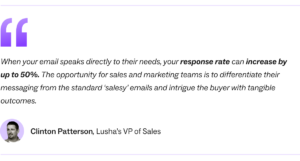 Email remains a powerful sales tool, with 96% of sales leveraging it to connect with potential clients. However, many sales teams still approach emails with the wrong goal in mind. A well-crafted cold email invites quick replies rather than commitment, making it easier for recipients to engage. After all, people are often more inclined to send a quick reply than to book a 30-minute call.
Email remains a powerful sales tool, with 96% of sales leveraging it to connect with potential clients. However, many sales teams still approach emails with the wrong goal in mind. A well-crafted cold email invites quick replies rather than commitment, making it easier for recipients to engage. After all, people are often more inclined to send a quick reply than to book a 30-minute call.
Think of it this way: cold emailing is like swiping on a dating app. If your opening line is all about marriage and settling down, you’ll likely get left on read. Instead, aim to build a genuine conversation—something that creates interest without pressure. Transitioning from “Let’s get serious” to “What’s your favorite pizza topping?” can mean the difference between ghosting and landing a coffee date.
The Golden Rule: Personalization
Personalization matters. This might not be groundbreaking, but finding the right level of personalization isn’t always obvious. Ideally, you’d give every prospect the same level of attention, but with limited time and resources, it’s about choosing where to focus your energy.
Success lies in categorizing leads and tailoring your outreach to what you value most.
Let’s break it down:
Tier 1 Prospects: Hyper-Personalization for Decision Makers
DO: Tier 1 prospects represent your highest-value lead. These are decision-makers and executives who need research and personalization that show genuine effort. Standard outreach rules don’t apply here; instead, invest time in understanding their latest initiatives. For instance, look at their LinkedIn profile for recent posts—maybe they’ve shared insights from an industry event or announced a new strategy. Mentioning this signals you’ve done your homework. Data shows that executives’ open rates are nearly as high as mid-level contacts’—21% versus 23%—indicating they’re engaged and ready to collaborate, provided, of course, that your message resonates.
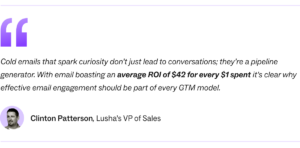
DON’T: Don’t miss the opportunity to connect with these key decision-makers by tossing them into generic email campaigns. Instead, focus on building meaningful relationships through personalized messaging that aligns with their unique needs and interests. Hyper-personalization is all about getting to know your prospect beyond their title. Check out their background and interests, and dive into what their company is all about, including their values and goals. Understanding their industry terminology and pain points helps, too! By blending these insights into your emails, you’ll create a more genuine connection that resonates and shows you truly care about their unique needs.
Example of an email for a Tier 1 Prospect:
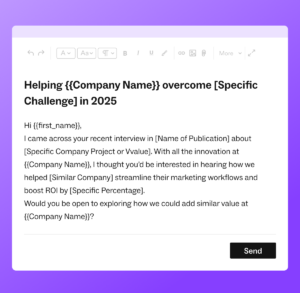
Tiers 2 and 3 Prospects: Scaled Personalization Using Templates
Tier 2 and Tier 3 leads are contacts with relevant updates, such as recent funding rounds or job changes. Hyper-personalization might be impractical for your Tier 2 and Tier 3 leads, but you still want to stand out. To be effective, aim for a personalized approach that can still scale.
This is where sales engagement platforms come in handy.
Sales engagement platforms, like Lusha’s Lists feature, allow you to segment prospects based on significant signals. By categorizing prospects—such as those who have recently received funding or been promoted—you can create templates that address their needs while maintaining a sense of personalization.
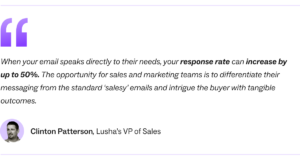
To make a templated email feel personalized, we suggest following these guidelines:
- DO Explain the Purpose: Let the recipient know why you’re reaching out. Mention specific factors that make your product relevant to them.
- DO End with a Simple Question: Use an open-ended question that’s easy to respond to, such as “Does this align with your current goals?” Simple questions prompt engagement and make replying easy.
- DO Use Dynamic Fields: Include dynamic fields (such as “industry” or “recent changes”) to inject relevant data into the email. This gives each email a customized feel without requiring manual edits.
- DON’T Spend Time Personalizing Subject Lines: Subject lines still need to be personalized, but you can afford to take some shortcuts. Many sales engagement platforms like Lusha Engage, have personalization tools like dynamic variables. Plug in fields like {{first_name}}, {{company name}}, or {{job_title}} to automatically pull unique data on each prospect into your subject line.“When your email speaks directly to their needs, your response rate can increase by up to 50%. The opportunity for sales and marketing teams is to differentiate their messaging from the standard ‘salesy’ emails and intrigue the buyer with tangible outcomes” – Clinton Patterson, Lusha’s VP of Sales
Example of an email for Tier 2 Prospect:
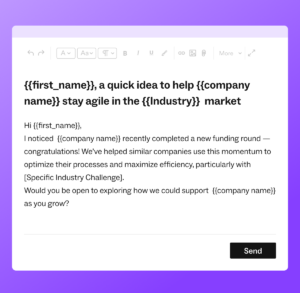
Key Elements of a Strong Cold Email
Now that we’ve covered the key concepts, let’s talk about the specific components you can adopt to make your emails effective.
- Craft a Subject Line They Can’t Ignore
Your subject line is your first (and maybe only) impression. It needs to be relevant, specific, and engaging. Try personalized subject lines like:
“Quick question about [Specific Company Goal]”
“[First Name], here’s how [Company Name] can save 30% on [Specific Area]”
- Tell Them Why They Should Care
Whether it’s a Tier 1 or Tier 3 prospect, the “why” should be crystal clear. Imagine you’re the recipient and ask yourself, “What’s in it for me?” Answer this directly.
- Explain Why You’re Reaching Out
Don’t make prospects guess why you’re in their inbox. Briefly state your purpose using simple, direct language. Are you reaching out because you’ve noticed a key industry challenge? Or because your solution can save them time and money? Recipients appreciate upfront communication that doesn’t require reading between the lines.
- Be Relevant, Even When It’s Automated
Automated emails are tricky — they can sound generic and impersonal if not done right. This is where sub-segmentation comes in. By creating distinct audience segments, you can target groups based on industry, role, company growth phase, or other relevant criteria. Automation doesn’t mean losing relevance. In fact, it should increase it.
- Keep It Short and Sweet
The average office worker receives over 100 emails daily, so keeping things brief is your best friend. Aim for 2-3 short paragraphs, ideally under 120 words total. Think of your email as a quick elevator pitch- no fluff, just value.
- End with a Friendly, Open-Ended Question
Because your goal is to get a response, end your email with a simple question. This soft close keeps the door open for them to engage. An open-ended question signals you’re genuinely interested in hearing their thoughts and allows the conversation to flow. Try asking:
- “Would it be helpful if we connected?”
- “Any interest in learning more?”
Cold Email Success: Turning Strategy into Connection
Writing a winning cold email isn’t about spamming the masses. By combining thorough research with automation and thoughtful targeting, you can deliver relevant emails that get responses.
Remember, cold emailing isn’t a one-size-fits-all approach. The more intentional your efforts, the greater your chances of success. So, the next time you send a cold email, take a breath, check your personalization, and go for it!
Psst… did you know? We’ve put together some stats and top tips from experts to ensure your cold emails lead to hot results.
- Open Rates: The average open rate for cold emails is around 15-28%, depending on the industry. Personalization and a compelling subject line can significantly increase this rate.
- Response Rates: Response rates for cold emails typically hover around 1-5%, but with targeted and well-crafted messages, some marketers report response rates as high as 10% or more.
- Personalization Matters: Emails that include a recipient’s name and personalized content can increase open rates by 26% compared to generic emails. Personalization is key to making an email feel relevant and engaging.
- Timing Is Everything: Sending cold emails on Tuesdays and Thursdays yields higher open and response rates. The best times to send emails are often early in the morning or during lunch hours.
- Follow-up is Crucial: Studies show that 70% of salespeople give up after one follow-up. However, connecting with a prospect often takes 5-7 touches. Persistence can pay off.
- Conciseness is Key: The ideal length for a cold email is between 50-125 words. Short, to-the-point emails tend to perform better because they respect the recipient’s time.

